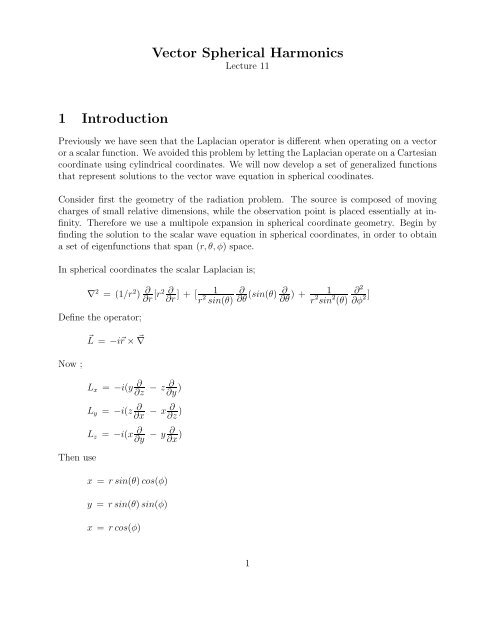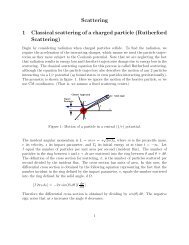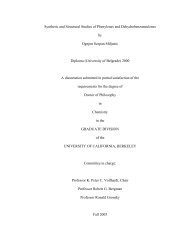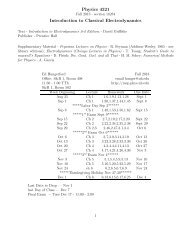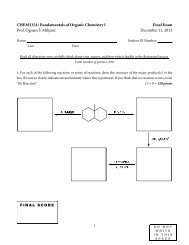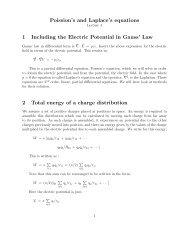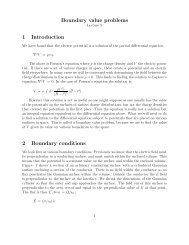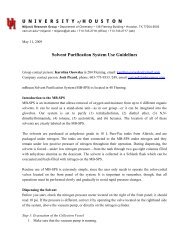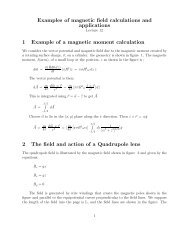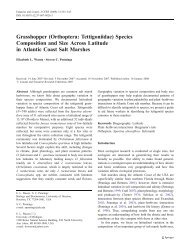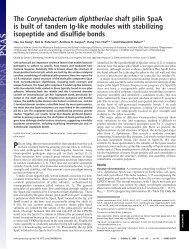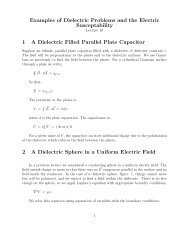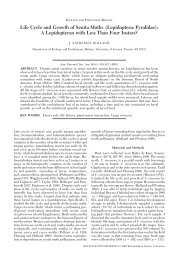Vector Spherical Harmonics 1 Introduction
Vector Spherical Harmonics 1 Introduction
Vector Spherical Harmonics 1 Introduction
You also want an ePaper? Increase the reach of your titles
YUMPU automatically turns print PDFs into web optimized ePapers that Google loves.
<strong>Vector</strong> <strong>Spherical</strong> <strong>Harmonics</strong>Lecture 111 <strong>Introduction</strong>Previously we have seen that the Laplacian operator is different when operating on a vectoror a scalar function. We avoided this problem by letting the Laplacian operate on a Cartesiancoordinate using cylindrical coordinates. We will now develop a set of generalized functionsthat represent solutions to the vector wave equation in spherical coodinates.Consider first the geometry of the radiation problem. The source is composed of movingcharges of small relative dimensions, while the observation point is placed essentially at infinity.Therefore we use a multipole expansion in spherical coordinate geometry. Begin byfinding the solution to the scalar wave equation in spherical coordinates, in order to obtaina set of eigenfunctions that span (r, θ, φ) space.In spherical coordinates the scalar Laplacian is;∇ 2 = (1/r 2 ) ∂ ∂r [r2 ∂ ∂r ] + [ 1r 2 sin(θ)Define the operator;⃗L = −i⃗r × ⃗ ∇∂∂θ (sin(θ) ∂ ∂θ ) + 1r 2 sin 2 (θ)∂ 2∂φ 2 ]Now ;Then useL x = −i(y ∂ ∂z − z ∂∂y )L y = −i(z ∂∂x − x ∂ ∂z )L z = −i(x ∂∂y − y ∂∂x )x = r sin(θ) cos(φ)y = r sin(θ) sin(φ)x = r cos(φ)1
By transforming to the spherical set of coordinates;L x = i[sin(φ) ∂ ∂θL y = i[−cos(φ) ∂ ∂θL z = −i ∂∂φThen note that ;+ cot(θ) cos(φ)∂∂φ ]+ cot(θ) sin(φ) ∂∂φ ]⃗L · ⃗L = L 2 = [1sin(θ) ∂θ ∂ (sin(θ) ∂θ ∂ ) + 1sin 2 (θ)∂ 2∂φ 2 ]Finally the scalar wave equation in spherical coordinates is ;[∇ 2 + k 2 ]V = [(1/r 2 ) ∂ ∂r [r2 ∂ ∂r ] + (1/r2 )L 2 ]V = 02 EigenfunctionsWe seek a solution of the above equation in the form V = F l (kr) YlM (θ, φ). The YlMthe spherical harmonic eigenfunctions;areY mlL 2 Y ml= (−1) m [= l(l + 1) Y ml(2l + 1)(l − m)!]4π(l + m)1/2 Pl m (cos(θ)) e imφL z Y ml= m Y mlThe ladder operators can also be defined as ;L ± = L x ± iL y = e ±iφ ( ∂ ∂θ ± i cot(θ) ∂∂φ )and shown to produce an eigenfinction of L z with m ± 1L z [L ± Ylm ] = (m ± 1) YlmThe boundry condition requires the solution be continuous between φ and φ+2π so that m isan integer. The boundry condition that the Legendre function Plm remain finite at θ = 0, πrequires that l be an integer. A solution to the associated Legnedre equation requires that−l ≤ m ≤ l. Substitution into the scalar wave equation gives the radial d.e.2
[ d2dr 2 + (2/r) d dr + k2 −l(l + 1)r2]F l = 0The solution is composed of spherical Bessel functions, which for scatering purposes arecombined to form the spherical Hankel functions, h 1 l and h 2 l . These are.F l (kr) = h 1,2)l(kr) = (π/2x) 1/2 [J l+1/2 (x) ± iN l+1/2 (x)]The asymptotic forms of the Hankel functions are ;h 1,2llim x→∞ (−i) l+1e±ixx3 Expansion of a vector fieldUse the definition of the vector operator defined above.⃗L = −i⃗r × ⃗ ∇⃗∇ = ˆr ∂ ∂r − (i/r2 )[⃗r × ⃗ L]Then any vector field can be expanded in a form;⃗V = ⃗ ∇ψ 1 + ⃗ Lψ 2 + ( ⃗ ∇ × ⃗ L)(ψ 3 /i)where ψ j j = 1, 2, 3 are arbitrary scalar functions. This is proved by using the fact than anyvector can be decomposed in an irrotational vector (curl = 0) and a solenoidal vector (divergence= 0). We do not show the proof of the above expansion but this can be demonstratedby obtaining the values of the ψ j functions for an arbitrary vector. Given this expansion,write;⃗B = ⃗ ∇ψ 1 + ⃗ Lψ 2 + ( ⃗ ∇ × ⃗ L)(ψ 3 /i)Also ⃗ ∇ · ⃗B = 0 and from the definition ⃗ ∇ · ⃗L = 0 the expansion of the vector field and thedivergence condition independently of ψ 1,3 can be satisfied. Therefore write;⃗B = ⃗ Lψ 2A similar development for ⃗ E can be obtained when we set ⃗ ∇ · ⃗E = 0, a condition we canobtain even in the presence of charge as will be observed later.3
For an example, consider the magnetic field of a current loop. From Ampere’s law in steadystate,⃗∇ × ⃗ B = µ ⃗ J = ⃗ ∇ × ⃗ ∇ × ⃗ AChoose a gauge where ⃗ ∇ · ⃗A = 0. The equation to be solved is ;∇ 2 ⃗ A = −µ ⃗ JWe have previously seen that the above equation for the vector Laplacian in spherical coordinatesis quite complicated. In general, define the 3 expansion vectors as above.⃗V lm = ˆr[−[2l l + + 11 ]1/2 Yl m ] + ˆθ[ 1 ∂Y M[(l + 1)(2l + 1)] 1/2 l∂θ ] + ˆφ[ im[(l + 1)(2l + 1)] 1/2 sin(θ) Y m⃗W lm = ˆr[[ l2l + 1 ]1/2 Yl m ] + ˆθ[ 1 ∂Y M[l(2l + 1)] 1/2 l∂θ ] + ˆφ[ im[l(2l + 1)] 1/2 sin(θ) Y l m ]⃗χ lm = ˆθ[ −m[l(2l + 1)] 1/2 sin(θ) Y l M ] + ˆφ[ −i ∂Y m[l(2l + 1)] 1/2 l∂θ ]These 3 functions span the 3-D space and are an orthorgonal set such that;l ]∫ ⃗A ∗lm · ⃗B l ′ m ′ dΩ = δ ABδ ll ′δ mm ′In the above ⃗ A lm , ⃗ B lm are any of the above functions. Note that if θ ′ = π −θ and φ ′ = π+φ.Then⃗V (θ ′ , φ ′ ) = (−1) l+1 ⃗ V (θ, φ)⃗W(θ ′ , φ ′ ) = (−1) l+1 ⃗ W(θ, φ)⃗χ(θ ′ , φ ′ ) = (−1) l ⃗χ(θ, φ)We also find that;⃗∇ · [F(r) V ⃗ lm ] = −(2l l + + 11 )1/2 [ dfdr + l + r2 F]Ylm⃗∇ · [F(r) W ⃗ lm ] = ( l2l + 1 )1/2 [ dfdr − l − r1⃗∇ · [F(r)⃗χ lm ] = 0F]Y mlThen the condition that ⃗ ∇ · ⃗A = 0 removes the projection of ⃗ A onto ⃗ V or ⃗ W. Note that ⃗ Land ∇ 2 commute.4
L 2 ⃗ L = ⃗ LL2L i ∇ 2 = ∇ 2̷L iThe equation to be solved is then;∇ 2 [R(r)⃗χ lm ] = [ d2 Rdr 2 + (2/r) dRdr−l(l + 1)r 2R]⃗χ lmBecause in this example there is no azmuthal dependence, m = 0 and we choose makethe boundry conditions finite as r → ∞, we expect a solution of the following form when∇ 2 ⃗ A = 0.⃗A l ∝ r −(l+1) [−i ∂Y 0[l(l + 1)] 1/2 l∂θ ]ˆφThese solutions can be used to construct the Green function from which a solution for ⃗ J ≠ 0can be obtained. There are other possible sets of vector spherical harmonics. For example,Morse and Feshbach use ⃗ B, ⃗ C, and ⃗ P in which the angular components are entirely in ⃗ P.5


